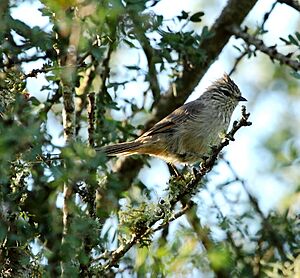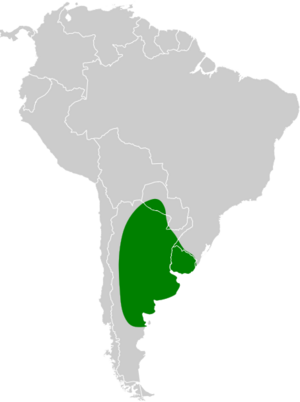Tufted tit-spinetail facts for kids
Quick facts for kids Tufted tit-spinetail |
|
|---|---|
 |
|
| Tufted tit-spinetail at Santa Fe Province, Argentina | |
| Conservation status | |
| Scientific classification | |
| Genus: |
Leptasthenura
|
| Species: |
platensis
|
 |
|
The tufted tit-spinetail (Leptasthenura platensis) is a small, active bird found in parts of South America. It belongs to the ovenbird family, which is known for building interesting nests. This bird gets its name from the small "tuft" or crest on its head and its tail feathers that look a bit spiny at the ends. You can find it in countries like Argentina, Brazil, and Uruguay.
Contents
What the Tufted Tit-Spinetail Looks Like
This bird is about 15 to 17 centimeters (6 to 7 inches) long, which is about the size of a small sparrow. It weighs around 10 to 12 grams (less than half an ounce). Both male and female tufted tit-spinetails look the same.
Feathers and Colors
They have a thin, light stripe above their eyes. Their face is a dull grayish-brown. The top of their head has a dark brown crest with lighter streaks. Their back and rump are dull grayish-brown, and their tail feathers are dark brownish-gray with a bit of reddish-brown at the tips of the outer feathers. The tail is special because the feathers get narrower at the ends, making them look a bit spiny.
Their wings are mostly grayish-brown with some lighter edges. The throat and upper chest are whitish with faint brownish marks. The rest of their belly is pale grayish-brown. Their eyes are brown, and their bill (beak) is black with a pale bottom part. Their legs and feet are a dark olive-green color. Young tufted tit-spinetails don't have the crest and their tail feathers are rounded.
Where the Tufted Tit-Spinetail Lives
The tufted tit-spinetail lives in northern and central Argentina, in a small part of southern Brazil, and in most of Uruguay. People have also seen it in Paraguay, but scientists are still checking if it truly lives there all the time.
Bird Habitats
This bird likes many different places. You can find it in forests near rivers, dry scrublands, dry woodlands, and bushy areas. It lives from sea level up to about 1,000 meters (3,300 feet) high in the mountains.
How the Tufted Tit-Spinetail Behaves
Most tufted tit-spinetails stay in the same area all year round. However, some birds might travel a bit outside their usual home range.
What the Bird Eats
The tufted tit-spinetail eats arthropods, which are small creatures like insects and spiders. It usually hunts for food in pairs or small family groups. They look for food from the lower bushes all the way up to the tops of trees. They mostly find their prey by picking it off leaves, small branches, and the bark of trees. Sometimes, they even hang upside down to reach tasty bugs!
Reproduction and Life Cycle
Tufted tit-spinetails usually breed in the spring and summer months in the Southern Hemisphere. They are thought to stay with one partner. They build a cup-shaped nest using twigs, grass, feathers, and hair. They like to build their nests inside holes, such as natural tree cavities, old woodpecker holes, or even old nests made by other ovenbirds, like the "mud ovens" built by horneros.
A female bird usually lays two to four eggs, but sometimes up to six. The eggs hatch after about 14 to 15 days. The young birds are ready to leave the nest about 15 or 16 days after they hatch. Both parent birds work together to feed and care for their babies.
Bird Calls and Songs
The song of the tufted tit-spinetail starts with clear, sharp notes and then speeds up into a trill that goes down in pitch, sounding like "tsi, tsirrrrr." Their most common call is a series of short notes followed by a sharp trill, like "pit-pit-pit … prrr." Another way to describe their call is "tswee tswee tswee tittle-tit" ending with a rattling sound.
Tufted Tit-Spinetail Status
The IUCN (International Union for Conservation of Nature) has said that the tufted tit-spinetail is a species of "Least Concern." This means it is not currently in danger of disappearing. It lives in a very large area, and even though we don't know the exact number of birds, scientists believe their population is stable. There are no major threats to this bird right now. It is considered common in many places where it lives.


